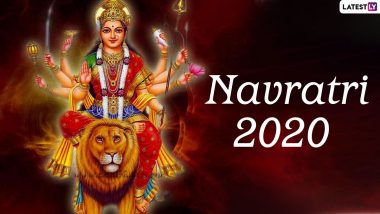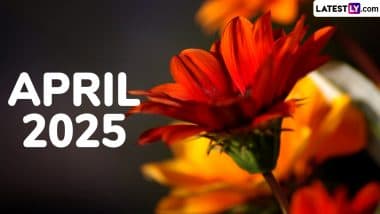One of the most significant Hindu festivals, Sharad Navratri or Sharadiya Navaratri is upon us and people are all geared up to celebrate this fun-filled festival. Navratri 2020 will be celebrated from October 17 to October 25. The nine-day long fun & fervour filled celebration will end on October 25, 2020, with Dussehra or Vijaya Dashami festival. The nine-day festival is commemorated differently across the country, but all in the honour of Maa Shakti. It celebrates the nine forms of Goddess Durga, also known as Navdurga. In this article, we bring you all the details on Navratri 2020 Dates, Free Hindu Calendar in PDF, panchang, tithi, day-wise significance of Sharad Navaratri and puja vidhi to worship nine avatars of Goddess Durga.
There are different ways of commemorating this festival, the major reason for celebrating Sharad Navaratri is to celebrate the victory of good over evil, as Goddess Durga emerges victorious over the buffalo demon to help restore Dharma. One of the most significant aspects of celebrating Navratri has to be the daily prayers and aartis offered to the different forms of Goddess Durga. Each day of Navaratri is dedicated to one form of the Goddess and has a story behind it. From Devi Shailputri on the first day of Navaratri to Devi Siddhidatri on Navratri Day 9, there is mythological folklore behind each goddess who is worshipped. You can download Navratri 2020 Colours List With Dates in PDF Format For Free Online!
Navaratri Day 1 - Goddess Shailputri - October 17 (Saturday)
The first day of Navaratri is dedicated to Goddess Shailaputri (which translates to a daughter of the mountain). The origin story of this Goddess, who is said to be a direct incarnation of Mahakali, is timed after the self-immolation of Goddess Sati. Parvati is said to have taken birth as the daughter of Lord Himalaya, and that is where here name was coined. This day often begins with Ghatasthapana or Kalash Sthapana, and Goddess Shailaputri is then revered with aartis and mantras. Devotees also offer fresh Jasmine flowers to the goddess on this day.
Navaratri Day 2 - Goddess Brahmacharini - October 18 (Sunday)
The second day of Navratri is dedicated to Goddess Brahmacharini, a reincarnation of Goddess Parvati at the home of Daksha Prajapati. The unmarried form of Goddess Parvati is worshipped as Goddess Brahmacharini. She is revered with the mantra Om Devi Brahmacharinyai Namah॥ and is believed to govern Lord Mangal, the provider of all fortunes.
Navaratri Day 3 - Goddess Chandraghanta - October 19 (Monday)
The third day of Navaratri will be celebrated on October 1, 2019, and is dedicated to Goddess Chandraghanta, the married avatar of Goddess Parvati. According to Hindu mythology, Parvati Maa started adorning her forehead with half Chandra after getting married to Lord Shiva, hence the name. Goddess Chandraghanta is known for her peaceful demeanour and looks for the welfare of her devotees. However, she is also ready for war with all her weapons.
Navaratri Day 4 - Goddess Kushmanda - October 20 (Tuesday)
The fourth day of Navaratri or Chaturthi is dedicated to worshipping Goddess Kushmanda, Parvati Maa’s incarnation who has the power and capability to live inside the Sun. Kushmanda Maa is believed to provide direction and energy to the sun. She is also known as Ashtabhuja Devi as she dons eight hands. Devotees offer red coloured flowers to the Goddess on the fourth day of Navaratri.
Navaratri Day 5 - Goddess Skandamata - October 21 (Wednesday)
The fifth day of Navaratri is dedicated to the mother of Lord Skanda, Skanda Mata. This avatar of the Goddess is believed to govern planet Budha and is said to be mounted on a ferocious lion. Goddess Skandamata carries her baby Skanda (also known as Kartikeya or Murugan) in her lap and it is believed that the devotees who worship her also get blessings of Lord Kartikeya.
Navaratri Day 6 - Goddess Katyayani - October 22 (Thursday)
Goddess Katyayani is the avatar that Parvati Maa took in order to destroy the demon, Mahishasura. One of the most violent forms of the Goddess, Maa Katyayani is known as the warrior goddess and is revered on the sixth day of Navratri. It is customary for devotees to specially offer red roses to Goddess Katyayani. The sixth day of Navaratri also marks the first day of Saraswati Puja or Saraswati Avahan which goes on to the next day.
Navaratri Day 7 - Goddess Kalaratri - October 23 (Friday)
The seventh day of Sharad Navaratri is the second day of Saraswati puja, which is also known as Saraswati Pradhan Puja day. It also marks the first day of Durga Puja or Pujo. On this day, the avatar of Goddess Durga who is worshipped is Kalaratri Maa. This is the form that Goddess Parvati took when she removed outer golden skin to kill demons named Shumbha and Nishumbha. The fiercest form of Maa Parvati, Goddess Kalaratri is said to govern the planet, Shani. The goddess is often showered with Night Blooming Jasmine by her devotees.
Navaratri Day 8 - Goddess Mahagauri - October 24 (Saturday)
The eight-day of Navaratri, also known as Durgashtami is dedicated to Goddess Mahagauri. She is believed to govern the planet Rahu and is mounted on a bull, just like Goddess Shailputri. This is the reason that Mahagauri Maa is also revered as Vrisharudha. On this day, devotees also perform Sandhi Puja, at the juncture when Ashtami Tithi ends and Navami Tithi starts. It is believed that Devi Chamunda appeared during this time to kill the demons, Chanda and Munda.
Navratri Day 9 - Goddess Siddhidatri - October 25 (Sunday)
The last day of Navaratri is dedicated to worshipping Goddess Sidhidatri, the supreme goddess of shakti (power) who appeared from the left half of Lord Shiva. Known to bestow siddhi (enlightenment) upon her devotees, she is also said to govern the planet Ketu. On the ninth day of Navaratri, people from South India also perform Ayudha Puja, where they worship all the vehicles by decorating them with vermillion, garlands and flowers. In addition to this people also perform Ashwina Navami Homa or Navami Homam where they chant 700 verses from Durga Saptashati and seek the blessings of Goddess Durga.
While the ways of celebrating Navaratri may differ across India, the ethos of this festival remains the same - the good always beats the evil. We hope you have a happy Navaratri.
(The above story first appeared on LatestLY on Oct 16, 2020 12:38 PM IST. For more news and updates on politics, world, sports, entertainment and lifestyle, log on to our website latestly.com).













 Quickly
Quickly





















